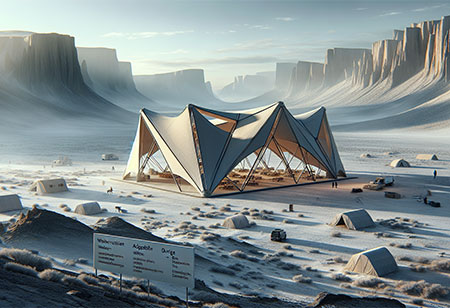
When it comes to pushing the boundaries of where and how work can be done, companies today are embracing solutions that would've sounded like science fiction just a few decades ago.
Imagine setting up a fully operational base in the heart of the icy tundra or the scorching desert. That's where an advanced fabric structure comes into play. These structures are not your average tents; they are engineering feats capable of safeguarding personnel and equipment in the most unforgiving climates.
From bustling mining operations to remote construction projects, the challenge isn't just fighting off the cold or heat - it's making these extreme places a second home for those who dare to tread there.
Advanced Materials Ushering Durable and Sustainable Solutions
It's the 21st century, and with textile innovations galloping forward, the materials used for these fabric structures are nothing short of extraordinary. They resist ripping and tearing, ward off mold and mildew, and provide insulation against the most severe temperature swings.
These materials don't merely endure; they excel, forming the backbone of shelters that stand like fortresses against the elements. The added bonus is their lightweight nature, making them easier to transport to distant locations where traditional building materials would balk at the journey. These shelters are more than temporary fixes; they're sustainable solutions meant to outlast their intended purposes, often getting repurposed for other missions down the line due to their exceptional durability.
Innovative Shelters that Bring Resilience to Challenging Work Sites
In mining and construction, where every square foot counts and time is money, innovative shelters are worth their weight in gold. Operators can rest easy knowing their million-dollar equipment is under the protective wing of a fabric shelter expertly configured for maximal space efficiency.
Imagine these structures, popping up like mushrooms after a spring rain, ready for action in a fraction of the time it takes for traditional construction to get off the ground. These custom solutions are not just about throwing up four walls and a roof. They're about creating a workflow-enhancing layout that responds to the nuances of an industry that doesn't have the luxury of second chances.
Overcoming the Logistical Challenge of Remote Location Setups
One of the thorniest problems with remote locations isn't just getting there - it’s bringing everything you need along for the ride. It's a logistical ballet, with each piece needing to arrive in unison. The ease with which fabric structures can be transported and assembled makes them a logistical dream.
Sections can be made to fit in standard shipping containers and then assembled on-site, like building blocks crafted for efficiency. These aren't just tents but self-contained worlds capable of supporting life and work away from civilization. They're a sanctuary, offering comfort and convenience with minimal reliance on local resources, a magic trick in the middle of nowhere.
The Sustainability Factor: Temporary Constructions Carving a Niche
Temporary might sound short-lived, but it's exactly this 'here today, gone tomorrow' feature that gives fabric buildings their green stripes. In a world where every footstep on nature might be one too many, these structures allow enterprises to tread lightly and leave no trace behind. They are the ninjas of the construction world - silent, stealthy, and gone before you know it.
On top of the ecological benefits of these leave-no-trace setups, communities benefit from a sprinkle of economic magic. Such projects often involve local workers, creating jobs and leaving behind a legacy of skills and experience that can form the foundation of new, sustainable local industries.
The Strategic Edge: The Role of Adaptable Structures in Defence operations
Speed and adaptability are everything in defence, and fabric structures deliver both by the truckload. Designed for rapid deployment and resilience, these shelters give military operations an edge, supporting troops with a level of mobility traditional buildings could never match.
Whether in the heat of the desert or the cold of the arctic, these tactical sanctuaries can be adapted for multiple uses - from housing soldiers to safeguarding equipment. These structures are required to meet exacting military specifications, providing peace of mind that no matter where they're deployed, they'll stand up to the task - whether that's withstanding fierce weather or offering a bastion of normality in a world turned upside down by conflict.
We use cookies to ensure you get the best experience on our website. Read more...